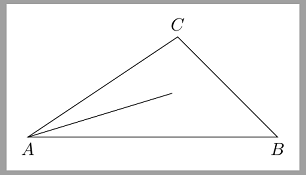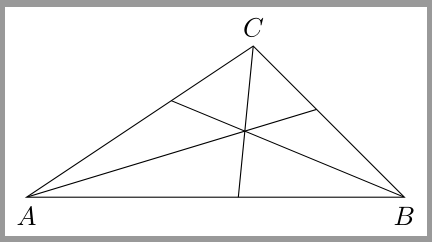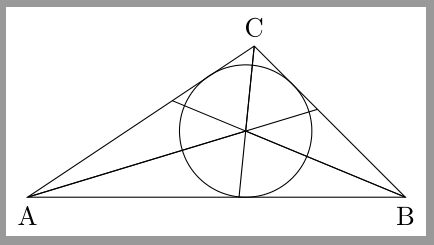|
Ich hab hier ein komplexes Beispiel. Ich möchte die Winkelhalbierende bis zur gegenüberliegenden Dreiecksseite verlängern.
Wenn das Beispiel zu aufwendig ist, kann ich auch ein minimaleres Beispiel erstellen. \documentclass[border=5pt, varwidth]{standalone} %\documentclass[]{article} \usepackage[utf8]{inputenc} \usepackage[ngerman]{babel} \usepackage[T1]{fontenc} \usepackage{amsmath,amsfonts,amssymb} \usepackage{tikz} \usetikzlibrary{calc} \begin{document} \begin{tikzpicture}[scale=1] % Dreieck % Koordinaten der Eckpunkte \pgfmathsetmacro{\xA}{0} \pgfmathsetmacro{\yA}{0} \pgfmathsetmacro{\xB}{5} \pgfmathsetmacro{\yB}{0} \pgfmathsetmacro{\xC}{3} \pgfmathsetmacro{\yC}{2} \coordinate[label=below:$A$] (A) at (\xA,\yA); \coordinate[label=below:$B$] (B) at (\xB,\yB); \coordinate[label=above:$C$] (C) at (\xC,\yC); % Dreieck zeichnen \draw[] (A) -- (B) -- (C) -- cycle; % Seitenlängen \pgfmathsetmacro{\a}{sqrt((\xB - \xC)^2 + (\yB - \yC)^2)} \pgfmathsetmacro{\b}{sqrt((\xA - \xC)^2 + (\yA - \yC)^2)} \pgfmathsetmacro{\c}{sqrt((\xA - \xB)^2 + (\yA - \yB)^2)} % Inkreis % Koordinate des Inkreismittelpunktes \pgfmathsetmacro{\p}{\a+\b+\c} \pgfmathsetmacro{\xW}{(\a*\xA + \b*\xB + \c*\xC)/\p} \pgfmathsetmacro{\yW}{(\a*\yA + \b*\yB + \c*\yC)/\p} \coordinate (W) at (\xW,\yW); % Inkreisradius \pgfmathsetmacro{\s}{\p/2} \pgfmathsetmacro{\r}{sqrt(((\s-\a)*(\s-\b)*(\s-\c))/\s)} % Inkreis zeichnen %\draw[blue] (W) circle[radius=\r]; % Winkelhalbierende bis Inkreismittelpunkt W \draw[] (A) -- (W); %\draw[] (B) -- (W); %\draw[] (C) -- (W); % Verlängerung bis gegenüberliegende Dreiecksseite %\coordinate[label=below:] (Wa) at (,); %? ? ?? ? ?? ? ?? ? ? %? ? ?? ? ?? ? ?? ? ? %? ? ?? ? ?? ? ?? ? ? \end{tikzpicture} \end{document} |
|
Eine Möglichkeit wäre \path[path picture={ \foreach \p in {A,B,C}\draw[shorten >=-30cm](\p)--(W); }] (A)--(B)--(C)--cycle; Wenn man das Dreieck noch nicht gezeichnet hat, kann man das hier mit erledigen lassen. \documentclass[border=1pt]{standalone} \usepackage{tikz} \usetikzlibrary{calc} \begin{document} \begin{tikzpicture}[scale=1] % Dreieck % Koordinaten der Eckpunkte \pgfmathsetmacro{\xA}{0} \pgfmathsetmacro{\yA}{0} \pgfmathsetmacro{\xB}{5} \pgfmathsetmacro{\yB}{0} \pgfmathsetmacro{\xC}{3} \pgfmathsetmacro{\yC}{2} \coordinate[label=below:$A$] (A) at (\xA,\yA); \coordinate[label=below:$B$] (B) at (\xB,\yB); \coordinate[label=above:$C$] (C) at (\xC,\yC); % Seitenlängen \pgfmathsetmacro{\a}{sqrt((\xB - \xC)^2 + (\yB - \yC)^2)} \pgfmathsetmacro{\b}{sqrt((\xA - \xC)^2 + (\yA - \yC)^2)} \pgfmathsetmacro{\c}{sqrt((\xA - \xB)^2 + (\yA - \yB)^2)} % Inkreis % Koordinate des Inkreismittelpunktes \pgfmathsetmacro{\p}{\a+\b+\c} \pgfmathsetmacro{\xW}{(\a*\xA + \b*\xB + \c*\xC)/\p} \pgfmathsetmacro{\yW}{(\a*\yA + \b*\yB + \c*\yC)/\p} \coordinate (W) at (\xW,\yW); % Dreieck mit Winkelhalbierenden zeichnen \draw[path picture={ \foreach \p in {A,B,C}\draw[shorten >=-30cm](\p)--(W); }] (A)--(B)--(C)--cycle; \end{tikzpicture} \end{document}
Und mal noch eine mögliche Alternative für das ganze Beispiel: \documentclass[margin=1pt]{standalone} \usepackage{tikz} \usetikzlibrary{calc,intersections,through} \begin{document} \begin{tikzpicture} % Dreieck mit Winkelhalbierenden zeichnen \path[draw] [path picture={ \path [name path global=WinkelhalbierendeA,draw] (A)--($($(A)!30cm!(C)$)!.5!($(A)!30cm!(B)$)$); \path [name path global=WinkelhalbierendeB,draw] (B)--($($(B)!30cm!(A)$)!.5!($(B)!30cm!(C)$)$); \path [draw] (C)--($($(C)!30cm!(A)$)!.5!($(C)!30cm!(B)$)$); }] (0,0) coordinate[label=below:A] (A)-- (5,0) coordinate[label=below:B] (B)-- (3,2) coordinate[label=above:C] (C)-- cycle ; %Schnittpunkt der Winkelhalbierenden \path [name intersections={of= WinkelhalbierendeA and WinkelhalbierendeB, by={W}}] (W) edge (A) edge (B) edge (C); % Lot von W auf eine Dreiecksseite \path ($(A)!(W)!(B)$)coordinate(LotWaufAB); % Kreis zeichnen \node [draw,circle through={(LotWaufAB)}] at (W){}; \end{tikzpicture} \end{document}
Klasse! Doch nicht so ein triviales Problem, wie ich anfangs dachte.
(21 Jun '16, 22:47)
cis
|



